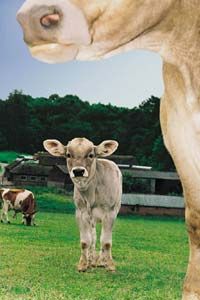“
 “This little guy wants grass for grub! See more extreme grilling pictures.Digital Vision/Thinkstock
“This little guy wants grass for grub! See more extreme grilling pictures.Digital Vision/Thinkstock
When it comes to beef, there’s a baffling array of options to choose from. But in the past 10 years or so, one option in particular has left many a beef fan scratching his or her head in puzzlement.
The dilemma we’re referring to is the decision whether to buy regular corn-fed beef or drop a few extra bucks and pick up the grass-fed variety. While the grass-fed meat industry is still small potatoes compared to corn-fed commerce, it’s growing at a steady rate. For example, in 2006, grass-fed beef amounted to less than 1 percent of the overall beef industry, but still brought in roughly $120 million in sales [source: Time].
So clearly a lot of people are jumping on the grass-fed beef bandwagon, which raises the question: Do they know something the rest of us don’t? Or are they just health nuts who’ll buy anything labeled "USDA Process Verified" and has support from animal and Earth advocates?
Well, as it turns out, grass-fed beef really might be worth those extra couple of dollars — at least if a person is actually concerned about eating healthily, humanely and with regard for the environment. That’s because the meat that’s from cattle that eat mostly corn is commonly considered less nutritious than that from cows allowed to graze on grass, their natural fare. Grass-fed cows do tend to taste a bit chewier than corn-fed cows — they get exercise as they move from pasture to pasture, so they’re more muscular — but when it comes to nutrients, they’re jam-packed.
On the next page, we’ll take a closer look at why grass-fed cows are becoming such, well, cash cows.


